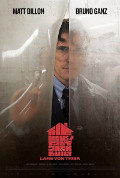
Directed by
Lars von Trier
153 minutes
Rated R
Reviewed by
Bernard Hemingway

The House That Jack Built
Reviewers of a Lars von Trier film often use words such as “challenging” and “confronting” more often than not weasel words that actually means that they didn’t like the film but it may be ART and thus feel wisest not to dismiss it out of hand. Von Trier, the self-styled enfant terrible of art cinema in an age when there are few such mavericks left knows well how to play this game.
The result has sometimes yielded substantial films such as Dancer In the Dark (2000) and Melancholia (2011) but his latest effort, The House That Jack Built is more attention-seeking than attention-worthy.
From its nursery rhyme title to Ray Charles ‘s swinging “Hit The Road Jack” that plays under the closing credits it is a grab-bag of pseudo-significance shoe-horned into what may loosely be called a serial-killer movie. Kurt Weil, Glenn Gould and Bob Dylan are amongst canonized geniuses pressed into service to boost Von Trier’s artistic bona fides. Whilst the relevance of these shout-outs is at best superficial his more sustained allusion to (predictably enough) Dante’s Inferno, unlike the role of 'The Seven Deadly Sins' in David Fincher’s Se7en (1995), is no more thorough-going.
Set over a period of some ten years The House That Jack Built is centred on the activities of the eponymous Jack (Matt Dillon, clearly relishing a lead role for once) an engineer and frustrated architect,who is building his own house on the banks of a picturesque lake. Apparently piqued by his failure to create anything that satisfies his dreams he periodically bulldozes the partially-built house and takes off in his red van on a random killing spree which, as he tells one of his victims, stands at sixty-one victims, soon to be sixty-two. As Jack goes about his business von Trier articulates his thoughts about the parallels between art and murder in a voice-over dialogue with Verge (Bruno Ganz), a modern-day equivalent of Dante’s Virgil.
Von Trier recreates Jack’s brutal killing of four women. First off he uses a tyre jack (this apparently is supposed to be a pun of sorts) to smash in the face of a woman (Uma Thurman, who was in von Trier’s Nymphomaniac Vols.1&2, 2011) with a rare capacity for inappropriate banter. He then strangles a widow who is gullible enough to let him into her house; shoots a mother and her pre-teen children and tops things off by tearing off the breasts of a living victim (Riley Keough). Yes, Jack, despite his wouldn't-hurt-a-fly looks, is a nasty piece of work.
Much of the film appears to be designed to cement von Trier’s bad boy reputation, especially at the accusations of misogyny that his films have often attracted (Nymphomaniac being a case in point) . “You think I’m a misogynist?” he seems to be asking. “ O.K. I’ll show you misogyny”. Then there is the trouble he got himself into at the Cannes premiere of Melancholia at which he claimed to be a Nazi. So here we get archival footage (seen many times before) of Nazi concentration camp victims being bulldozed (remember Jack's house) into a mass grave.
Beyond the sado-masochistic purlieus of academe where the film will likely find its only devotees is there anything about it that warrants your time, particularly a generous 153 minutes of it? Well there is the marvellous tableau of a storm-wept boat that echoes Eugene Delacroix’s 1822 painting, ‘The Barque of Dante’ (also known as ‘Dante and Virgil in Hell’) but aside from that and some beguiling visuals in the home stretch as Jack and Verge descend into Hell, I’d say no.
Want something different?





